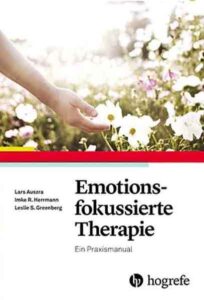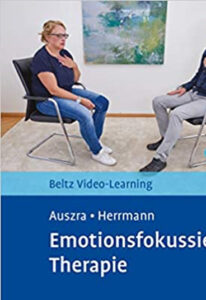Working group for scientific psychotherapy
Emotion-Focused Therapy
Emotion-Focused Therapy (EFT) according to Leslie S. Greenberg, is a scientifically based therapy method that focuses on awareness, acceptance, understanding, and changing emotions. The workshop focuses on how a patient can access their emotional experience, especially painful emotions such as shame, sadness, and fear, and how they can change dysfunctional emotions to improve their emotional competence. This increases a patient’s ability to address their problems. The EFT therapy model is presented with some of its important intervention techniques and practiced in small groups (two-chair technique, empty chair technique).

What is Emotion Focused Psychotherapy:
Emotion-Focused Therapy (EFT) according to L. Greenberg is a scientifically based psychotherapy approach that places emotions as the foundation of human experiences at the center of therapeutic action. The underlying assumption is that emotions influence thinking and behavior and that it is possible to work directly with emotions in order to change them. In therapeutic work, emotions are at the same time a guide to central needs and a motor or source of change.
From the perspective of EFT therapists, it is central to give more space to emotions in the therapeutic setting and to improve the patients’ ability to process emotions. That is, to help patients to consciously perceive emotions, to allow them, to accept them, to explore them, to make them understandable, to accept them and to make them usable.
With its focus on emotions, Emotion-Focused Therapy (EFT) reflects the latest findings in affective neuroscience and psychotherapy research.
Conceptual background:
The roots of Emotion-Focused Therapy (EFT) according to L. Greenberg lie in the humanistic, experience-oriented tradition of psychotherapy. It has been further developed through decades of research and is now based on current findings from psychological and neuroscientific emotion research as well as psychotherapy process and outcome research.
We now know that psychological problems and symptoms, regardless of a patient’s disorder, are usually due to difficulties in emotional processing. Findings from psychotherapy process research show that across the most important schools of psychotherapy, the depth of the patient’s experience promotes therapeutic success, as does a common focus of therapists and patients on emotional processes (Herrmann & Auszra, 2009).
The goal of emotion-focused therapy is to improve patients’ ability to process emotions. “Changing emotions with emotions” is one of the central guiding principles.
Based on a clinical theory of emotions, change models can be derived in emotion-focused therapy that have been empirically validated. It provides therapists with effective interventions and methods to work systematically and effectively with emotions in psychotherapy.
Emotion-focused therapy is a process-oriented approach. Therapists learn to work with their patients’ emotional experiences from moment to moment.
As “emotion coaches” they help patients find words for their inner experiences, better understand feelings, accept them, regulate them and transform unhelpful feelings. By getting in touch with your own feelings, inner pain can be alleviated and access to more vivid, empowering emotions such as pride and compassion can be gained.
Emotion-focused therapy (EFT) thus integrates empathic relationship building and process-directive therapeutic interventions (e.g. chair work) to improve emotional processing and change dysfunctional emotions.
Content:
Emotion-focused therapy is based on the following assumptions:
- Emotions are fundamentally adaptive; they represent a vital inner resource. They help us to quickly recognize what is important. They serve as a signaling system and as an inner compass for what we need when dealing with other people and to find our way in the world.
- Emotions play a central role in the organization of human experience and behavior as well as in the formation of the self.
- Emotions can help change problematic emotional reactions and dysfunctional self-experiences, such as feeling weak, incompetent, or unlovable.
Emotion-focused therapy distinguishes between different types of emotional experiences, each of which requires a different therapeutic approach. Most important is the distinction between primary and secondary and between adaptive and maladaptive emotions.
Emotion-focused therapists learn how to activate dysfunctional/maladaptive feelings in session and how to help patients better process their feelings. Above all, they help their patients to fundamentally and sustainably change dysfunctional/maladaptive, painful feelings by awakening their emotional resources, i.e. making healthier and helpful feelings accessible.
They make use of various basic principles of emotional processing (perception/awareness, regulation, reflection, transformation), which, supplemented by the distinction between emotion types and various processing difficulties, enable systematic work with emotions.
Empathy forms the basis of therapeutic action in the emotion-focused approach. It is at the same time a therapeutic technique and a fundamental mode of relationship formation.
State of research:
The effectiveness of emotion-focused therapy has been empirically proven (e.g. Goldman, Greenberg & Angus, 2006; Greenberg & Watson, 1998). It is one of the scientifically based therapeutic procedures (see APA, Division 12; Lambert 2004; Grawe 1998).
In comparative studies with classic person-centered therapy (Goldman et al., 2006; Greenberg and Watson, 1998) and cognitive behavioral therapy (Watson et al., 2003), emotion-focused therapy was superior to the other two forms of therapy in the treatment of interpersonal difficulties.
There is also a wealth of evidence on individual change processes. For example, Goldman et al. (2005) and Pos et al. (2003) show that the “depth of experience” as an operationalization of a patient’s emotional processing ability predicts the success of therapy.
Greenberg and colleagues (Greenberg et al., 2007) demonstrated that the quality of expressed emotional arousal is more important for treatment success than the level of expressed emotional arousal alone. Effective emotional processing means unlocking the meaning of emotional experience and arriving at new emotionally based meanings.
Institute for Emotion-Focused Therapy (IEFT)
German Society for Emotion-Focused Therapy eV

ISBN-10: 3801724255
ISBN-13: 978-3801724252
Publisher: Hogrefe Publishing
Edition: 1st edition. (December 2016)
Language: German
Price: €36.95

ISBN-10: 3621287620
ISBN-13: 978-3621287623
Publisher: Beltz Publishing
Edition: Feb 12, 2020
Language: German
Price: €58.79

